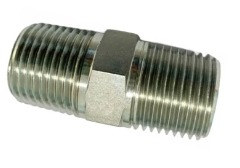When it comes to plumbing, automotive, or industrial applications, understanding thread types is essential. NPT, or National Pipe Thread, is a commonly used thread type. But how do you know if a thread is NPT? In this detailed guide, we’ll explore the characteristics of NPT threads, provide expert insights, and answer frequently asked questions to help you become a thread identification pro.
How Do I Know If Thread Is NPT?
NPT threads are known for their unique characteristics:
Tapered Thread Profile
NPT threads have a tapered profile. This means that the diameter of the threads gradually decreases along the length of the thread. This tapering is crucial for creating a tight seal in pipe connections.
Thread Angle
The thread angle on NPT threads is 60 degrees. This differs from other thread types like NPS (National Pipe Straight), which have a 55-degree thread angle.
Thread Pitch
NPT threads use a taper thread pitch system, measured in threads per inch (TPI). The taper and TPI together ensure a secure, leak-free connection.
Sealant Required
One of the distinctive features of NPT threads is that they require thread sealant to create an airtight and watertight seal. This is a crucial step in working with NPT threads.
Common Sizes
NPT threads come in various sizes, with 1/8″, 1/4″, 3/8″, 1/2″, 3/4″, 1″, 1 1/4″, and 1 1/2″ being some of the most common sizes used in plumbing and pipe fittings.
Identifying NPT Threads in Practice
To identify NPT threads in practice, follow these steps:
Measure the Thread Diameter: Use a caliper or thread pitch gauge to measure the diameter of the threads. NPT threads will have a gradually decreasing diameter along their length.
Check the Thread Angle: Use a thread angle gauge to verify that the thread angle is 60 degrees. This angle is a telltale sign of NPT threads.
Count the Threads Per Inch: NPT threads will have a taper thread pitch, typically specified in threads per inch (TPI). Count the number of threads in one inch to confirm.
Inspect for Sealant: If you notice remnants of thread sealant on the threads, it’s a strong indicator that you’re dealing with NPT threads.
FAQs About NPT Threads
Can NPT Threads Be Used for Gas Lines?
Yes, NPT threads are suitable for gas lines. Their tapered design and requirement for sealant make them ideal for creating a secure connection in gas applications.
What’s the Difference Between NPT and NPS Threads?
NPT threads are tapered with a 60-degree thread angle and are used for creating tight seals. In contrast, NPS threads are straight with a 55-degree thread angle and are typically used in applications where sealing is not critical.
Do NPT Threads Require Teflon Tape?
Yes, using Teflon tape or pipe thread sealant is essential for NPT threads to ensure a proper seal and prevent leaks.
Can You Convert NPT Threads to NPS Threads?
Converting NPT threads to NPS threads is possible with the use of a thread adapter. However, it’s crucial to ensure a proper seal when making this conversion.
Are NPT Threads Interchangeable with Other Thread Types?
NPT threads are not interchangeable with other thread types like NPS or BSPT (British Standard Pipe Taper). Attempting to use incompatible threads can result in leaks and other issues.
Where Are NPT Threads Commonly Found?
NPT threads are commonly found in plumbing fittings, pipes, and various industrial applications, making them widely used in construction and manufacturing.
Final Note
Identifying NPT threads is essential for anyone working with pipes and fittings. By understanding their unique characteristics, taper, thread angle, and the need for sealant, you can confidently recognize NPT threads and use them effectively in your projects.
Remember to measure the diameter, check the thread angle, count the threads per inch, and look for sealant residue to confirm that you’re dealing with NPT threads. Now that you’re equipped with this knowledge, you can tackle your projects with confidence.
Post time: Sep-30-2023


